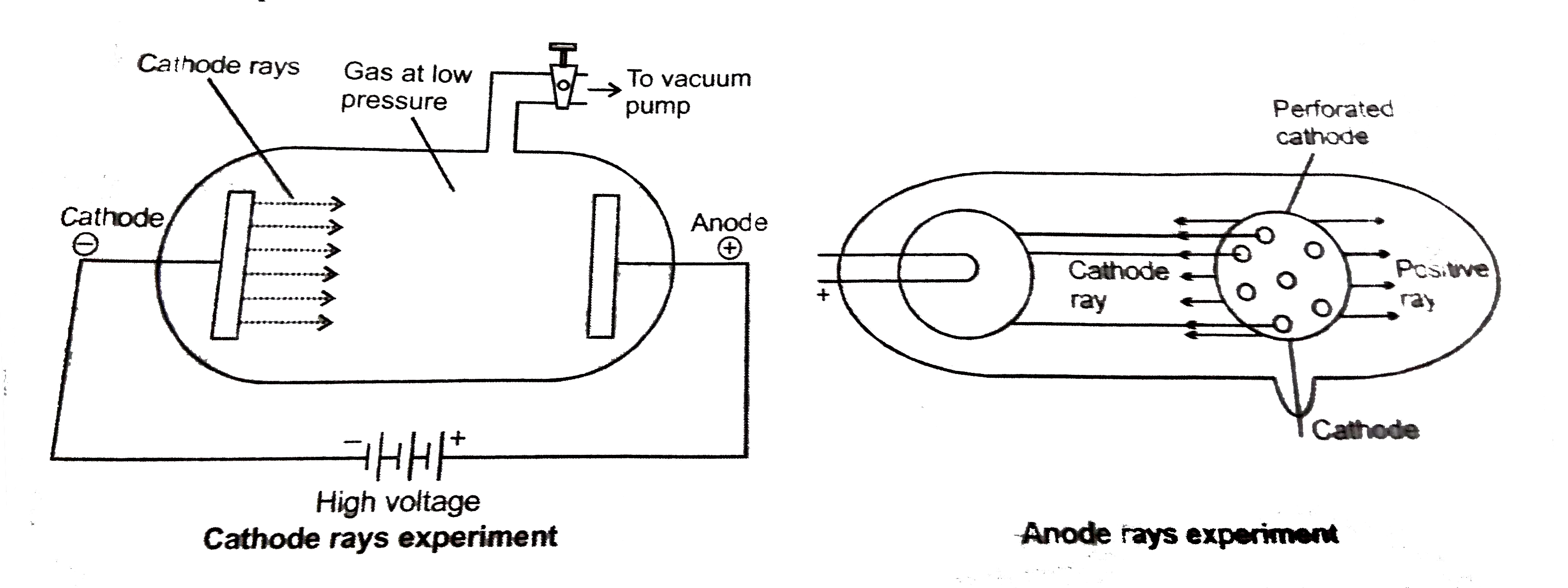Charles Darwin and his son, Francis experimented with phototropism of grass seedlings by placing a metal foil blindfold over different parts of the seedling's coleoptile. A simplified version of their results is shown below. Which of the following statements best explains their results?
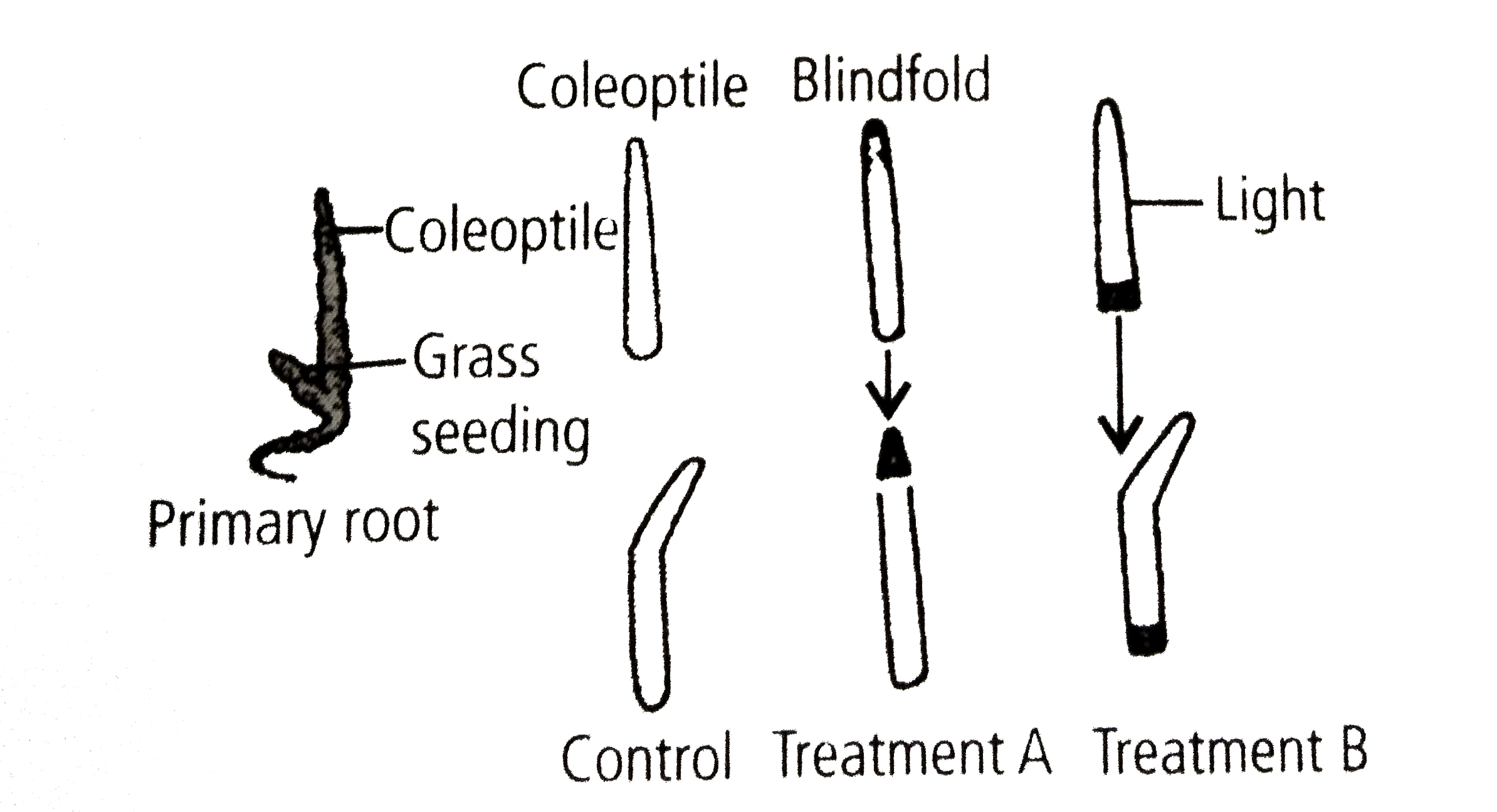
a) The light signal is perceived a few milimetres below the tip, and these cells cause the coleoptile to grow toward the light.
b) Both the seedling root and coleoptile perceie and respond to light in the same manner.
c) A chemical messenger must travel from the base of the coleoptile to the tip.
d) The light signal is perceived at the tip of the coleoptile, but the growth response occurs a few milimetres below the tip.
The correct Answer is:d
Step by step video, text & image solution for Charles Darwin and his son, Francis experimented with phototropism of grass seedlings by placing a metal foil blindfold over different parts of the seedling's coleoptile. A simplified version of their results is shown below. Which of the following statements best explains their results? by Biology experts to help you in doubts & scoring excellent marks in Class 11 exams.
Updated on:21/07/2023Topper's Solved these Questions
- PLANT GROWTH AND DEVELOPMENTBOOK - NCERT FINGERTPS ENGLISHCHAPTER - PLANT GROWTH AND DEVELOPMENTEXERCISE - Examplar problems
12 Videos
- PLANT GROWTH AND DEVELOPMENTBOOK - NCERT FINGERTPS ENGLISHCHAPTER - PLANT GROWTH AND DEVELOPMENTEXERCISE - Assertion & Reason
15 Videos
- PLANT GROWTH AND DEVELOPMENTBOOK - NCERT FINGERTPS ENGLISHCHAPTER - PLANT GROWTH AND DEVELOPMENTEXERCISE - Seed dormancy
5 Videos
- PHOTOSYNTHESIS IN HIGHER PLANTSBOOK - NCERT FINGERTPS ENGLISHCHAPTER - PHOTOSYNTHESIS IN HIGHER PLANTSEXERCISE - Photosynthesis In Higher Plants
136 Videos
- PLANT KINGDOMBOOK - NCERT FINGERTPS ENGLISHCHAPTER - PLANT KINGDOMEXERCISE - Plant Kingdom
160 Videos
Similar Questions
The existence of negatively charged particle in an atom was shown by J.J. Thomson as a result of the studies of the passage of electricity through gases at extremely low pressure known as discharge tube experiments. When a high voltage of the order of 10,000 volts or more was impressed across the electrodes, some sort of invisible rays moved from the negative electrode to the positive electrode these rays are called as cathode rays.
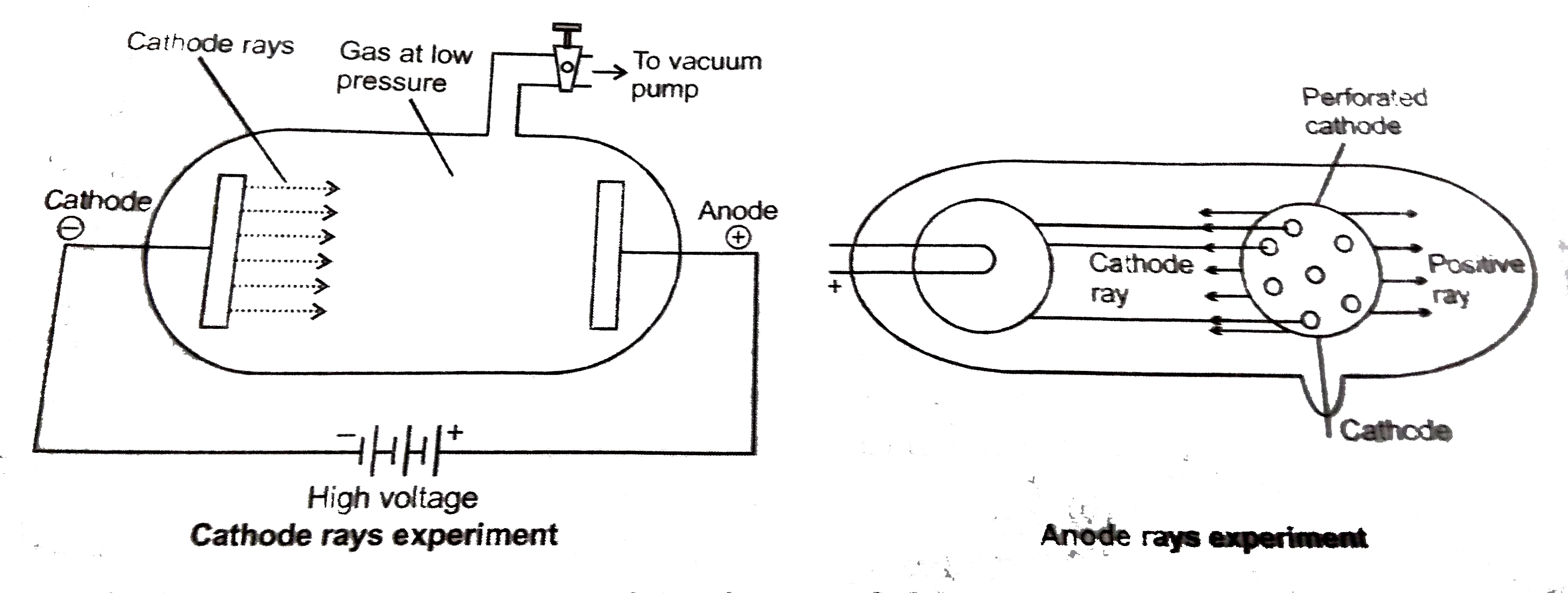
Cathode rays travel in straight path in absence of electrical and magnetic field . Cathode rays consist of material part and charged particles? Cathode rays produce X-rays and light is emitted when they strike on ZnS screen. Cathode rays penetrate through thin sheets of aluminium and other metals . They affect the photogenic plate and passes heating effect when they strike on metal foil. The raito of charge to mass i.e charge/mass is same for all the cathode rays irrespective of the gas used in the tube.
The existence of positively charged particle in an atom was shown be E. Goldstein. He repeated the same discharge tube experiments by using a perforated cathode. It was observed that when a high potential difference was applied between the electrodes, not only cathode rays were produced but also a new type of rays were produced simultaneoulsy from anode moving towards cathode and passes through the holes or canal of the cathode. These termed as canal rays or anode rays.
These rays travel in straight lines and consists of positively charged particles. These rays have kinetic energy and produces heating effect also. The e/m ratio of these rays is smaller than that of electrons. Unlike cathode rays, their e/m value is dependent upon the nature of the gas taken in the tube. These rays produced flashes of light on ZnS screen and can pass throughs thin metal foils. They can produce physical and chemical changes and are capable to produce ionisation in gases.
Select the incorrect statement.
View SolutionThe existence of negatively charged particle in an atom was shown by J.J. Thomson as a result of the studies of the passage of electricity through gases at extremely low pressure known as discharge tube experiments. When a high voltage of the order of 10,000 volts or more was impressed across the electrodes, some sort of invisible rays moved from the negative electrode to the positive electrode these rays are called as cathode rays.
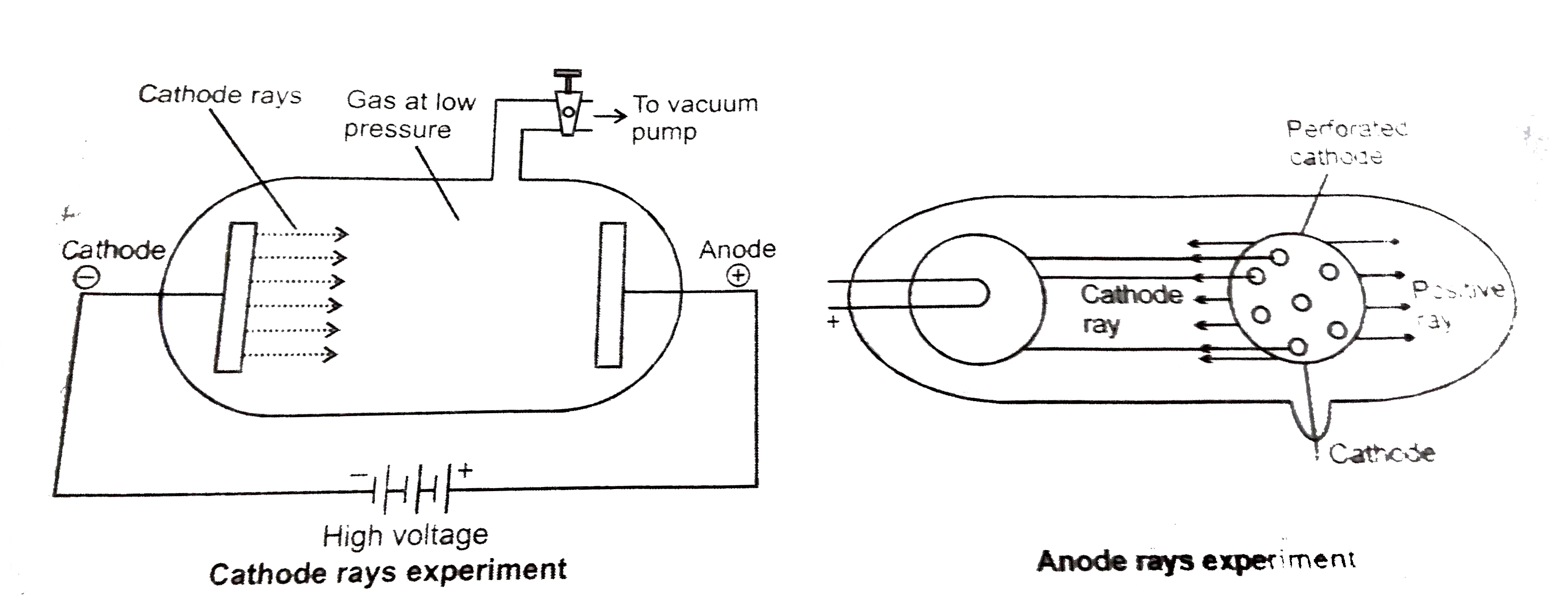
Cathode rays travel in straight path in absence of electrical and magnetic field . Cathode rays consist of material part and charged particles? Cathode rays produce X-rays and light is emitted when they strike on ZnS screen. Cathode rays penetrate through thin sheets of aluminium and other metals . They affect the photogenic plate and passes heating effect when they strike on metal foil. The raito of charge to mass i.e charge/mass is same for all the cathode rays irrespective of the gas used in the tube.
The existence of positively charged particle in an atom was shown be E. Goldstein. He repeated the same discharge tube experiments by using a perforated cathode. It was observed that when a high potential difference was applied between the electrodes, not only cathode rays were produced but also a new type of rays were produced simultaneoulsy from anode moving towards cathode and passes through the holes or canal of the cathode. These termed as canal rays or anode rays.
These rays travel in straight lines and consists of positively charged particles. These rays have kinetic energy and produces heating effect also. The e/m ratio of these rays is smaller than that of electrons. Unlike cathode rays, their e/m value is dependent upon the nature of the gas taken in the tube. These rays produced flashes of light on ZnS screen and can pass throughs thin metal foils. They can produce physical and chemical changes and are capable to produce ionisation in gases.
Which is not true with respect to cathode rays?
View Solution
Knowledge Check
This passage is adapted from Stephen Coleman, Scott Anthony, and David E. Morrison, “Public Trust in the News.” ©2009 by Stephen Coleman.
The news is a form of public knowledge. Unlike personal or private knowledge (such as the health of one’s friends and family, the conduct of a private hobby, a secret liaison), public knowledge increases in value as it is shared by more people. The date of an election and the claims of rival candidates, the causes and consequences of an environmental disaster, a debate about how to frame a particular law, the latest reports from a war zone—these are all examples of public knowledge that people are generally expected to know in order to be considered informed citizens. Thus, in contrast to personal or private knowledge, which is generally left to individuals to pursue or ignore, public knowledge is promoted even to those who might not think it matters to them. In short, the circulation of public knowledge, including the news, is generally regarded as a public good which cannot be solely demand-driven.
The production, circulation, and reception of public knowledge is a complex process. It is generally accepted that public knowledge should be authoritative, but there is not always common agreement about what the public needs to know, who is best placed to relate and explain it, and how authoritative reputations should be determined and evaluated. Historically, newspapers such as The Times and broadcasters such as the BBC were widely regarded as the trusted shapers of authoritative agendas and conventional wisdom. They embodied the Oxford English Dictionary’s definition of authority as the “power over, or title to influence, the opinions of others.” As part of the general process of the transformation of authority whereby there has been a reluctance to uncritically accept traditional sources of public knowledge, the demand has been for all authority to make explicit the frames of value which determine their decisions. Centres of news production, as our focus groups show, have not been exempt from this process. Not surprisingly perhaps some news journalists feel uneasy about this renegotiation of their authority:
Editors are increasingly casting a glance at the “most read” lists on their own and other websites to work out which stories matter to readers and viewers. And now the audience—which used to know its place—is being asked to act as a kind of journalistic ombudsman, ruling on our credibility (broadcast journalist, 2008).
The result of democratising access to TV news could be political disengagement by the majority and a dumbing down through a popularity contest of stories (online news editor, 2007).
Despite the rhetorical bluster of these statements, they amount to more than straightforward professional defensiveness. In their reference to an audience “which used to know its place” and conflation between democratisation and “dumbing down,” they are seeking to argue for a particular mode of public knowledge: one which is shaped by experts, immune from populist pressures, and disseminated to attentive, but mainly passive recipients. It is a view of citizenship that closes down opportunities for popular involvement in the making of public knowledge by reinforcing the professional claims of experts. The journalists quoted above are right to feel uneasy, for there is, at almost every institutional level in contemporary society, scepticism towards the epistemological authority of expert elites. There is a growing feeling, as expressed by several of our focus group participants, that the news media should be “informative rather than authoritative”, the job of journalists should be to “give the news as raw as it is, without putting their slant on it”, and people should be given “sufficient information” from which “we would be able to form opinions of our own.”
At stake here are two distinct conceptions of authority. The journalists we have quoted are resistant to the democratisation of news: the supremacy of the clickstream (according to which editors raise or lower the profile of stories according to the number of readers clicking on them online), the parity of popular culture with “serious” news, the demands of some audience members for raw news rather than constructed narratives.
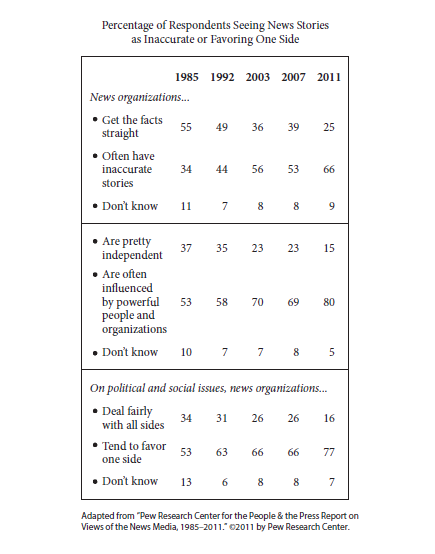
The authors indicate that the public is coming to believe that journalists’ reports should avoidApersonal judgments about the events reportedBmore information than is absolutely necessaryCquotations from authorities on the subject matterDdetails that the subjects of news reports wish to keep private.This passage is adapted from Stephen Coleman, Scott Anthony, and David E. Morrison, “Public Trust in the News.” ©2009 by Stephen Coleman.
The news is a form of public knowledge. Unlike personal or private knowledge (such as the health of one’s friends and family, the conduct of a private hobby, a secret liaison), public knowledge increases in value as it is shared by more people. The date of an election and the claims of rival candidates, the causes and consequences of an environmental disaster, a debate about how to frame a particular law, the latest reports from a war zone—these are all examples of public knowledge that people are generally expected to know in order to be considered informed citizens. Thus, in contrast to personal or private knowledge, which is generally left to individuals to pursue or ignore, public knowledge is promoted even to those who might not think it matters to them. In short, the circulation of public knowledge, including the news, is generally regarded as a public good which cannot be solely demand-driven.
The production, circulation, and reception of public knowledge is a complex process. It is generally accepted that public knowledge should be authoritative, but there is not always common agreement about what the public needs to know, who is best placed to relate and explain it, and how authoritative reputations should be determined and evaluated. Historically, newspapers such as The Times and broadcasters such as the BBC were widely regarded as the trusted shapers of authoritative agendas and conventional wisdom. They embodied the Oxford English Dictionary’s definition of authority as the “power over, or title to influence, the opinions of others.” As part of the general process of the transformation of authority whereby there has been a reluctance to uncritically accept traditional sources of public knowledge, the demand has been for all authority to make explicit the frames of value which determine their decisions. Centres of news production, as our focus groups show, have not been exempt from this process. Not surprisingly perhaps some news journalists feel uneasy about this renegotiation of their authority:
Editors are increasingly casting a glance at the “most read” lists on their own and other websites to work out which stories matter to readers and viewers. And now the audience—which used to know its place—is being asked to act as a kind of journalistic ombudsman, ruling on our credibility (broadcast journalist, 2008).
The result of democratising access to TV news could be political disengagement by the majority and a dumbing down through a popularity contest of stories (online news editor, 2007).
Despite the rhetorical bluster of these statements, they amount to more than straightforward professional defensiveness. In their reference to an audience “which used to know its place” and conflation between democratisation and “dumbing down,” they are seeking to argue for a particular mode of public knowledge: one which is shaped by experts, immune from populist pressures, and disseminated to attentive, but mainly passive recipients. It is a view of citizenship that closes down opportunities for popular involvement in the making of public knowledge by reinforcing the professional claims of experts. The journalists quoted above are right to feel uneasy, for there is, at almost every institutional level in contemporary society, scepticism towards the epistemological authority of expert elites. There is a growing feeling, as expressed by several of our focus group participants, that the news media should be “informative rather than authoritative”, the job of journalists should be to “give the news as raw as it is, without putting their slant on it”, and people should be given “sufficient information” from which “we would be able to form opinions of our own.”
At stake here are two distinct conceptions of authority. The journalists we have quoted are resistant to the democratisation of news: the supremacy of the clickstream (according to which editors raise or lower the profile of stories according to the number of readers clicking on them online), the parity of popular culture with “serious” news, the demands of some audience members for raw news rather than constructed narratives.
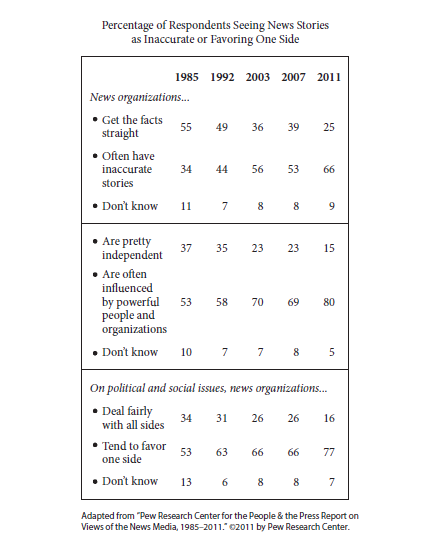
As used in line 24, “common” most nearly meansAnumerous.Bfamiliar.Cwidespread.Dordinary.This passage is adapted from Stephen Coleman, Scott Anthony, and David E. Morrison, “Public Trust in the News.” ©2009 by Stephen Coleman.
The news is a form of public knowledge. Unlike personal or private knowledge (such as the health of one’s friends and family, the conduct of a private hobby, a secret liaison), public knowledge increases in value as it is shared by more people. The date of an election and the claims of rival candidates, the causes and consequences of an environmental disaster, a debate about how to frame a particular law, the latest reports from a war zone—these are all examples of public knowledge that people are generally expected to know in order to be considered informed citizens. Thus, in contrast to personal or private knowledge, which is generally left to individuals to pursue or ignore, public knowledge is promoted even to those who might not think it matters to them. In short, the circulation of public knowledge, including the news, is generally regarded as a public good which cannot be solely demand-driven.
The production, circulation, and reception of public knowledge is a complex process. It is generally accepted that public knowledge should be authoritative, but there is not always common agreement about what the public needs to know, who is best placed to relate and explain it, and how authoritative reputations should be determined and evaluated. Historically, newspapers such as The Times and broadcasters such as the BBC were widely regarded as the trusted shapers of authoritative agendas and conventional wisdom. They embodied the Oxford English Dictionary’s definition of authority as the “power over, or title to influence, the opinions of others.” As part of the general process of the transformation of authority whereby there has been a reluctance to uncritically accept traditional sources of public knowledge, the demand has been for all authority to make explicit the frames of value which determine their decisions. Centres of news production, as our focus groups show, have not been exempt from this process. Not surprisingly perhaps some news journalists feel uneasy about this renegotiation of their authority:
Editors are increasingly casting a glance at the “most read” lists on their own and other websites to work out which stories matter to readers and viewers. And now the audience—which used to know its place—is being asked to act as a kind of journalistic ombudsman, ruling on our credibility (broadcast journalist, 2008).
The result of democratising access to TV news could be political disengagement by the majority and a dumbing down through a popularity contest of stories (online news editor, 2007).
Despite the rhetorical bluster of these statements, they amount to more than straightforward professional defensiveness. In their reference to an audience “which used to know its place” and conflation between democratisation and “dumbing down,” they are seeking to argue for a particular mode of public knowledge: one which is shaped by experts, immune from populist pressures, and disseminated to attentive, but mainly passive recipients. It is a view of citizenship that closes down opportunities for popular involvement in the making of public knowledge by reinforcing the professional claims of experts. The journalists quoted above are right to feel uneasy, for there is, at almost every institutional level in contemporary society, scepticism towards the epistemological authority of expert elites. There is a growing feeling, as expressed by several of our focus group participants, that the news media should be “informative rather than authoritative”, the job of journalists should be to “give the news as raw as it is, without putting their slant on it”, and people should be given “sufficient information” from which “we would be able to form opinions of our own.”
At stake here are two distinct conceptions of authority. The journalists we have quoted are resistant to the democratisation of news: the supremacy of the clickstream (according to which editors raise or lower the profile of stories according to the number of readers clicking on them online), the parity of popular culture with “serious” news, the demands of some audience members for raw news rather than constructed narratives.
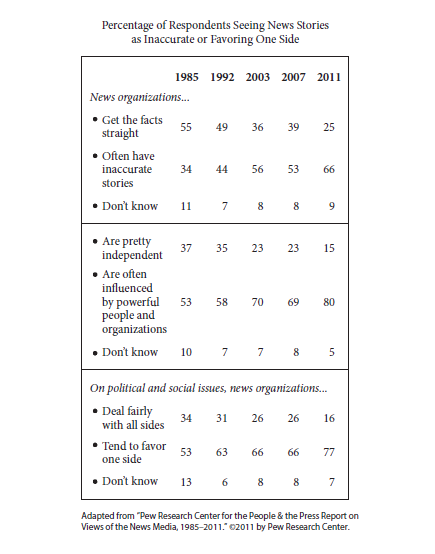
As used in line 74, “raw” most nearly meansAunfiltered.Bexposed.Charsh.Dinexperienced.

